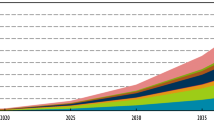Abstract
In March 1997 the European Commission adopted aproposal that increases existing minimum levels oftaxation on mineral oils by around 10 to 25% andintroduces excises for other energy products. Thispaper analyses the macroeconomic impacts of theproposal. It employs three models: HERMES, GEM-E3, andE3ME. All models confirm that the proposal will havepositive macroeconomic impacts when the tax revenuesare used to reduce social security contributions paidby employers. For the EU as a whole, both GDP andemployment are expected to be higher and CO2emissions are 0.9 to 1.6 percent lower. The positiveEU-wide effects can be observed in practically allmember states. The sector impacts are modest, with theenergy sector expected to face the most negativeimpacts. Differences between model results are due tothe model type (general equilibrium ormacro-econometric), the EU countries covered and theway tax exemptions were handled. Crucial assumptionsto obtain the ``double dividend'' are the modelling ofthe labour market and the impacts on EU externaltrade. The sensitivity of the results for the use oftax revenues, tax exemptions and tax rate increases isassessed.
Similar content being viewed by others
References
Barker, T. (1998), The Effects on Competitiveness of Co-Ordinated Versus Unilateral Fiscal Policies Reducing GHG Emissions in the EU: An Assessment of a 10% Reduction by 2010 Using the E3ME Model. E3ME Working Paper No. 28, Cambridge Econometrics, U.K.
Barker, T. (1998a), Achieving a 10% Cut in Europe's CO 2 Emissions Using Additional Excises Duties: Multilateral Versus Unilateral Action Using an E3 Model for Europe. E3ME Working Paper No. 29, Cambridge Econometrics, U.K.
Barker, T. and B. Gardiner (1996), ‘Employment, Wage Formation and Pricing in the European Union: Empirical Modelling of Environmental Tax Reform’, in C. Carraro and D. Siniscalco, eds., Environmental Fiscal Reform and Unemployment. Dordrecht: Kluwer Academic Publishers, pp. 229-272.
Bossier, F. et al. (1995), ‘Efficience énergétique et nouvelles technologies’, in European Commission, ed., Le progrès technologique pour la compétitivité et l'emploi. Brussels, pp. 87-111.
Bossier, F., L. Lemiale, S. Mertens, E. Meyermans, P. van Brusselen and P. Zagame (1997), Evaluation of Fiscal Measures for Energy Products: Results from the HERMES-Link System. Report Submitted to the European Commission, April 1997, Federal Planning Bureau/Erasme, Brussels/Paris.
Bovenberg, A. (1997), Environmental Policy, Distortionary Labour Taxation, and Employment: Pollution Taxes and the Double Dividend. Paper Presented at the EAERE Conference, Catholic University Brabant, Tilburg.
Cambridge Econometrics and Chambre de Commerce et d'Industrie de Paris (1997), Evaluation of Fiscal Measures for Energy Products: Results from the E3ME Model. Draft May 1997, report submitted to the European Commission, DGXII, Cambridge.
Capros, P., P. Georgakopoulos, S. Zografakis, S. Proost, D. van Regemorter, K. Conrad, T. Schmidt, Y. Smeers and E. Michiels (1996), ‘Double Dividend Analysis: First Results of a General Equilibrium Model (GEM-E3) Linking the EU-12 Countries’, in C. Carraro and D. Siniscalco, eds., Environmental Fiscal Reform and Unemployment. Dordrecht: Kluwer Academic Publishers, pp. 193-227.
Capros, P., P. Georgakopoulos and E. Kokkalakis (1996a), Evaluation of Fiscal Measures for Energy Products in European Union. Results from GEM-E3 and MIDAS Models. Report to the European Commission, DG XI. National Technical University of Athens, Athens.
Capros, P. and T. Georgakopoulos (1997), Evaluation of Fiscal Measures for Energy Products: Results from the GEM-E3 and MIDAS Models, May 23. Report Submitted to the European Commission, DGXII, National Technical University Athens.
Capros, P., T. Georgakopoulos, D. van Regemorter, S. Proost, T. Schmidt and K. Conrad (1997), ‘European Union: the GEM-E3 General Equilibrium Model’, Economic and Financial Modelling 4(2&3), 51-160.
Carraro, C. and D. Siniscalco (1996), Environmental Fiscal Reform and Unemployment. Dordrecht: Kluwer Academic Publishers.
European Commission (1995a), Amended Proposal for a Council Directive Introducing a Tax on Carbon Dioxide Emissions and Energy(COM (95) 172 final, dated 10.5.95). Brussels.
European Commission (1995b), E3ME, an Energy-Environment-Economy Model for Europe, EUR16715 EN, DGXII. Brussels.
European Commission (1997a), Proposal for a Council Directive Restructuring the Community Framework for the Taxation of Energy Products(COM 97(30) final, dated 12.3.97). Brussels.
European Commission (1997b), Presentation of the New Community System for the Taxation of Energy Products. Commission Staff Working Paper, SEC(97) 1026 (Part I and II). Brussels.
Goulder, L., I. Parry and P. Burtraw (1997), ‘Revenue-Raising vs. Other Approached to Environmental Protection: The Critical Significance of Pre-Existing Tax Distortion’, RAND Journal of Economics 28(4), 708-731.
Hourcade, J-C., E. Haites and T. Barker (1998), ‘Macroeconomic Cost Assessment’, in UNEP, ed., Mitigation and Adaptation Cost Assessment: Concepts, Methods and Appropriate Use. UNEP Collaborating Centre on Energy and the Environment, Riso National Laboratory, Roskilde, Denmark.
Italianer, A., G. d'Alcantara and P. Zagamé (1993), ‘The Hermes Model for the Member States of the European Community’, in Commission of the European Communities, ed., Hermes: Harmonized Econometric Research for Modelling Economic Systems. Amsterdam: North-Holland, pp. 15-64.
Majocci, A (1996), ‘Green Fiscal Reform: A Survey’, Environmental and Resource Economics 8, 375-397.
Repetto, R. and D. Austin (1997), The Costs of Climate Protection: A Guide for the Perplexed. Washington: World Resources Institute.
Author information
Authors and Affiliations
Corresponding author
Rights and permissions
About this article
Cite this article
Jansen, H., Klaassen, G. Economic Impacts of the 1997 EU Energy Tax: Simulations with Three EU-Wide Models. Environmental and Resource Economics 15, 179–197 (2000). https://doi.org/10.1023/A:1008309512349
Issue Date:
DOI: https://doi.org/10.1023/A:1008309512349




